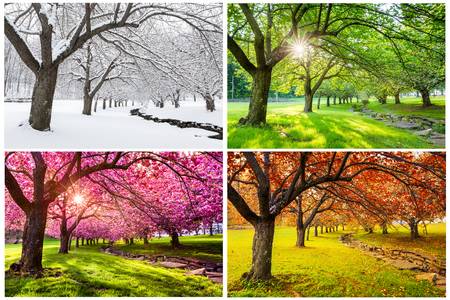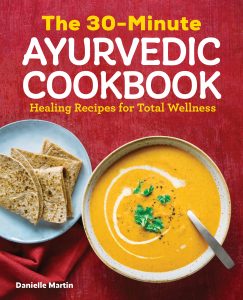 Dear Ask Ayurveda,
Dear Ask Ayurveda,
I live in the Pacific Northwest of North America. It rains A LOT in fall. Although I am beginning to crave warmer fall foods, I find some can be quite dampening (for example, winter squash, dairy. . .). Some days I feel so water-logged I want to binge on popcorn, yet I know you are supposed to avoid Vata-aggravating foods during the fall season. This has got me thinking about other folks whose seasons are more atypical — like in Arizona where it’s mostly dry or Greenland where it’s mostly snowy. So how do we adjust the seasonal Ayurvedic diet and lifestyle guidelines to fit our own unique microclimate? Rain City Girl, Vancouver Island BC
Dear Rain City Girl,
This is a great question that does not get addressed too often, so thank you so much for bringing it to light! Although Ayurveda has countless doshic guidelines laid out for each specific body-type, it must always be remembered that these are only GENERAL recommendations. This simply means that as an individual, we are all unique beings, no matter which doshic category we fall under. What works for one Vata type (or Pitta, or Kapha) will not necessary be the cure all for another Vata predominant individual. In order to give a well-rounded and effective treatment protocol, we must consider all factors involved, and not simply just follow the general recommendations that are listed for our body type, the current season, or whatever the case may be.
Like many places around the world, your Pacific Northwest climate is not falling under the “typical” paradigm for what we consider seasonal fall weather. For your case, this is because instead of the fall weather being extremely dry (Vata), your climate becomes much more damp (Kapha). Others individuals may find different trends in their own personal fall climate, such as continuing to be very hot (Pitta) all the way until December or January. So naturally, with these other environmental factors at play (and therefore other doshas), we must switch gears a bit and modify the general seasonal recommendations to meet your personal needs. In your case, this means making your Vata-reducing fall season regimen geared to calm both Vata and Kapha. This will then address the incoming cooler temperatures and windy environment (Vata), while still acknowledging the dampness (Kapha) that is so prevalent in your area this time of year.
If you are still with me, you may be at a head scratching point by now. This is because Ayurveda can be made extremely simple, or it can get kind of complicated. Before you get overwhelmed however, let’s get back to the basics. The best way to keep seasonal balance, no matter where you live, will be to break down your own personal climate to its unique qualities, and balance out these heightened qualities by welcoming more diet and lifestyle practices that will promote the opposite quality. If this seems too abstract, let us use your Northwest fall climate as an example.
The main qualities of a typical Northwest fall season include cool (due to the temperature), mobile (due to the wind and the transitional nature of fall), heavy (due to clouds, fog, etc) and damp (due to rain, humidity, etc). The cool/cold quality is shared by both Vata and Kapha and naturally will be reduced by adding in more warm, soupy foods, heating spices, and warming herbal teas. Sipping on hot lemon water throughout the day will also reduce the cool quality and pacify both Vata and Kapha. Warming practices will be beneficial such as dressing warm, taking hot ginger baths, and performing oil massages with sesame oil. Once again these will calm the cool quality and work to reduce both Kapha and Vata.
The second quality that becomes increased with the onset of fall is the mobile quality. Excess in this quality will naturally increase Vata and can create restless mind, difficulty concentrating, and sleep issues. In order to calm the mobile quality, we must adopt some stabilizing diet and lifestyle practices in our daily routine. **SIDE NOTE: Please remember that the Kapha is increased by the stabilizing quality, so in order to avoid provoking the heavy and damp Kapha qualities further, we must make sure the guidelines we choose will not be Kapha provoking.** Some stabilizing foods that will not provoke Kapha will then be ghee (in moderation), sesame oil (in moderation); warm, spiced almond milk; chicken broth, bone broth, soups (non-dairy), quinoa porridge, buckwheat groat porridge, and kitchari. Some stabilizing lifestyle practices that are not Kapha-provoking will be mediation, gentle Yoga, nadi shodhana (alternate nostril breathing), deep belly breathing, oil massage using a blend of sesame-sunflower oil, and walks in nature (if weather permits).
Finally we must look at the heavy and damp qualities that seem to be leaving you water-logged and craving popcorn. Naturally the heavy and damp qualities will find balance through the light and dry qualities. Now you are likely thinking, “won’t light and dry provoke my Vata this time of year?”; generally speaking the answer is yes! However, the heavy and moist quality is so prevalent in your environment, if we were to add a small amount of light and dry quality to the diet and lifestyle, the Vata should remain grounded (say a couple handfuls of popcorn rather than an entire bowl full). Furthermore we can add in Vata-reducing foods that are not increasing to the heavy or damp qualities. This will work to pacify Vata without creating heaviness or water-retention. Some examples are honey; lighter, less starchy whole grains (quinoa, buckwheat, well-cooked millet with ghee); sautéed greens with spices, lemon, and olive oil; steamed non-starchy veggies with ghee or olive oil; mung dal, red lentils, and quinoa kitchari. CCF tea will be a great addition as well, as it is tridoshic, great for the digestion and metabolism (to reduce heaviness), and an effective diuretic (to reduce water retention). Some light and dry, non-Vata-provoking practices include gentle cardio exercise, dry sauna (in moderation), ginger baths, and brisk walks.
So Rainy City Girl, here are a few notes to take home today:
- Break down the predominant qualities of your environment.
- Discover an appropriate routine that will balance these qualities without provoking any others.
- And most of all – go with what works for you and throw away anything that does not!
This is a complex question with a complex answer. I definitely suggest to read it through slowly and take some time to digest this information. If you are still feeling confused as to where to begin, this season or anytime, it may be best to find a knowledgeable holistic practitioner in your area to work with you one on one. If you have any follow up questions, I am always more than happy to help where I can as well.
Thank you again Rainy City Girl for this great question that is not talked about too much in the mainstream world of Ayurveda. I hope some of the suggestions will help to calm your Vata this fall without leaving you heavy, water-logged, and Kapha provoked. Good luck with the rainy season ahead and many blessings to you!
Namaste,
Ask Ayurveda


